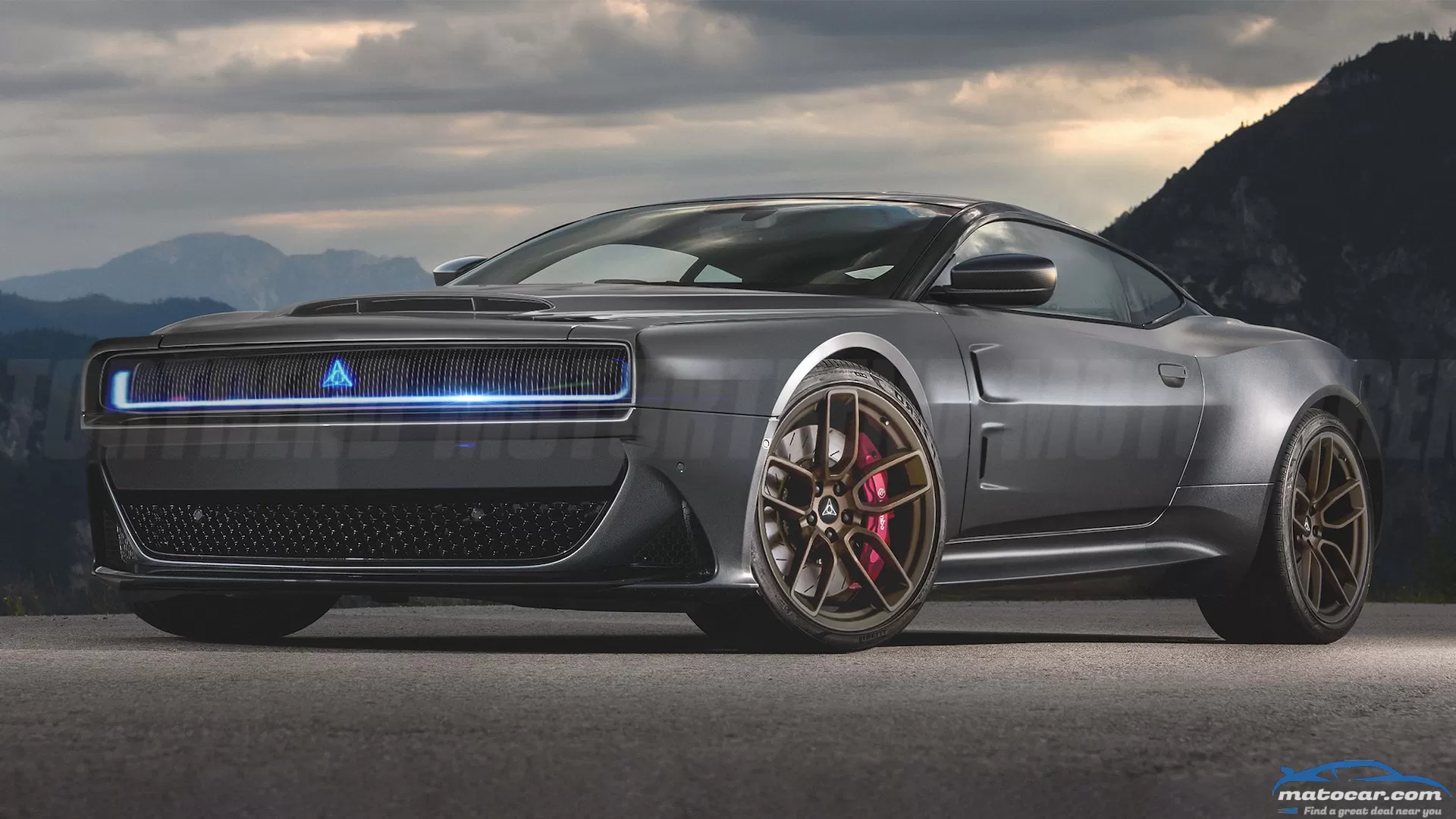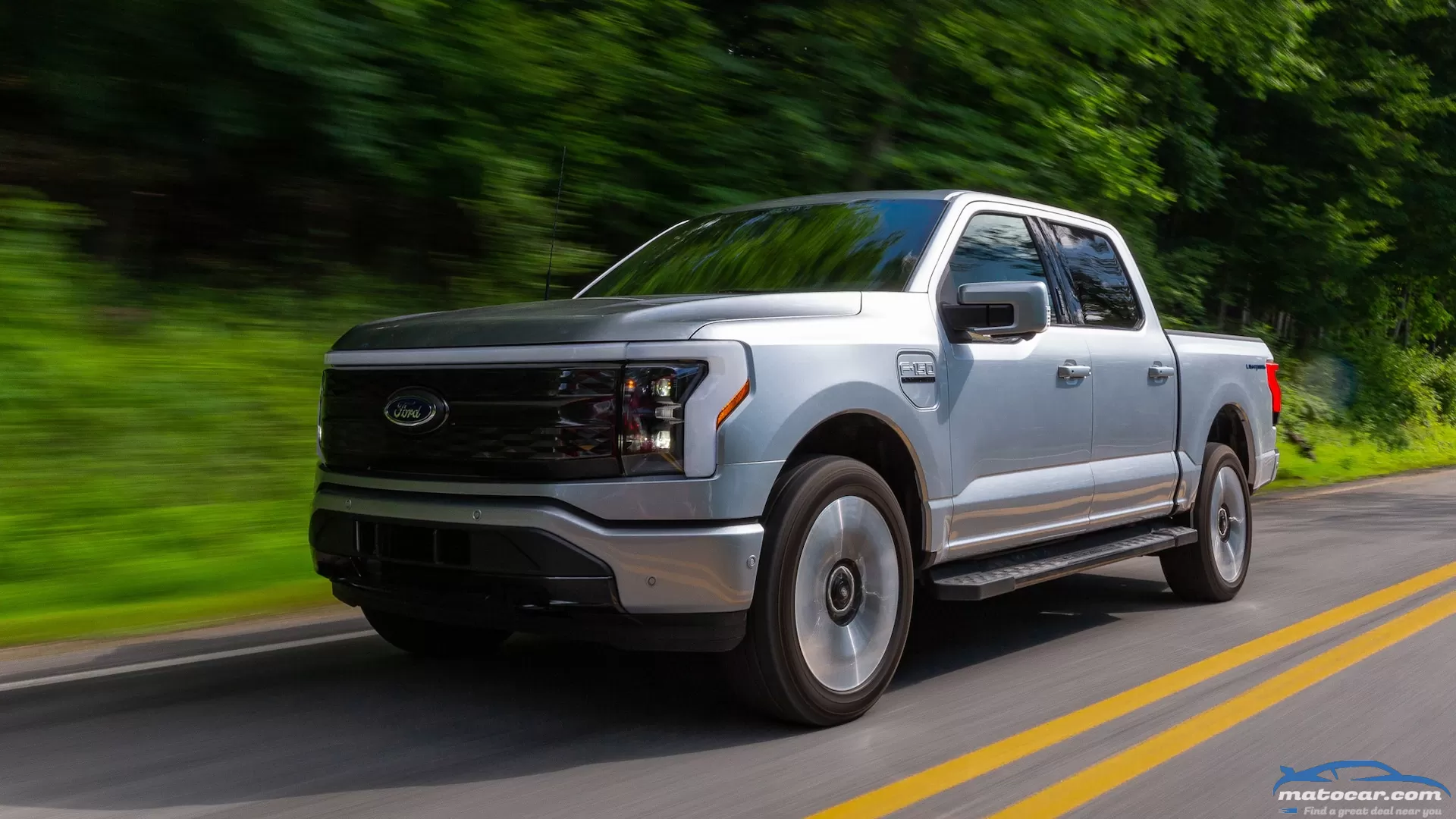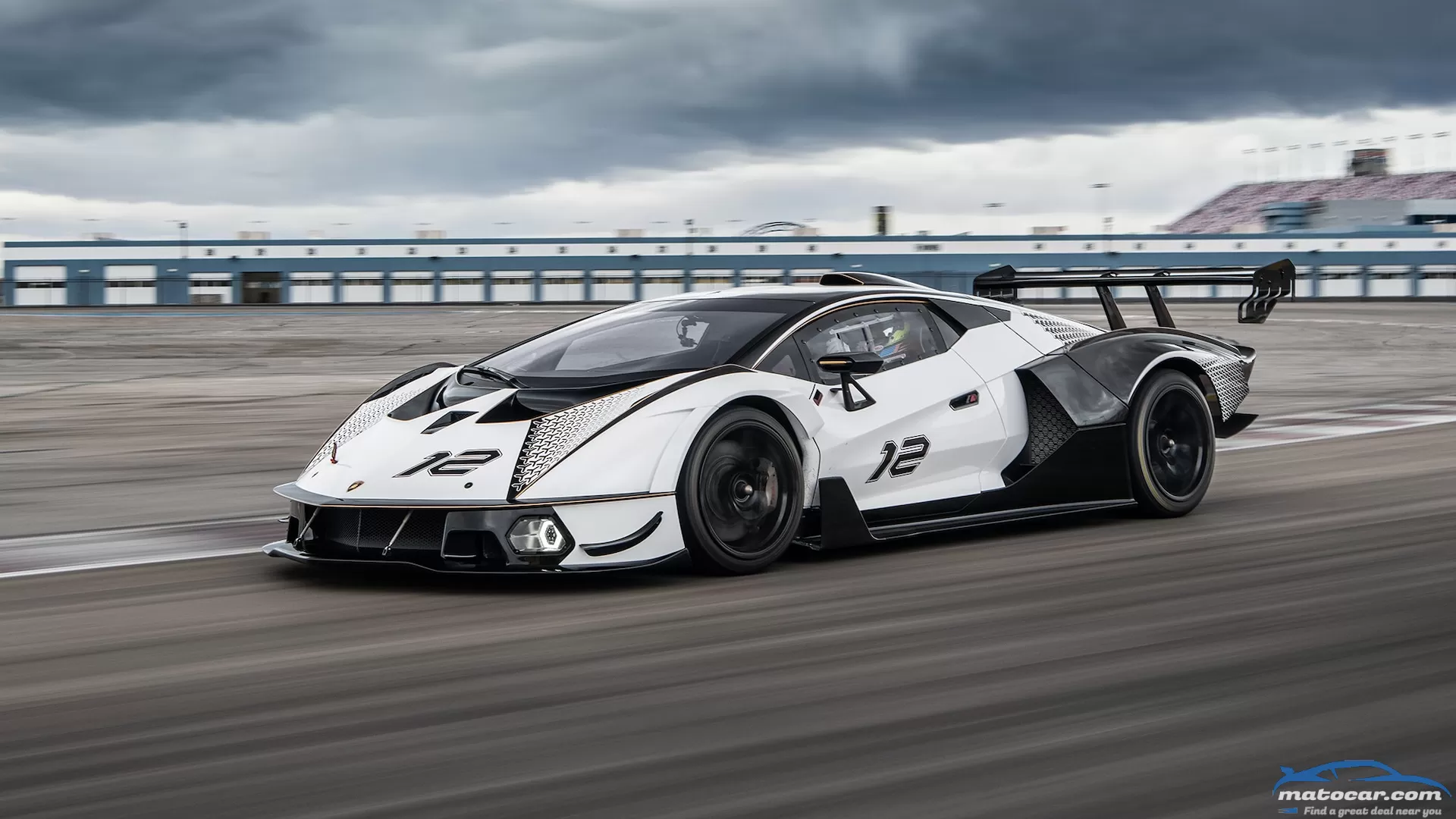2025 Dodge eMuscle Electric Muscle Car: Smoke All Four of ’Em

WHAT IT IS: A fully electrified hellsled from the automotive industry's gas-chuggingest, tire-smokingest, hair-on-your-chestiest brand, Dodge.
WHY IT MATTERS: When even Dodge is preparing to transition to EVs, it's time to accept the inevitable: The revolution will be rechargeable. Of course, that doesn't mean abandoning heritage. So Dodge, the marque behind the Challenger, Charger, Hellcat, Demon, and myriad other badass badges, is spinning up an electric muscle car as a bridge between its fully electrified future and its Hemi-powered past.
This car's retro flavor will help that mission. As seen in teaser images/video and our exclusive renderings, its boxy nose will ape those of classic Chargers—wouldn't that be an appropriate name to use on the EV?—from the golden period of muscle in the late '60s and early '70s; that era's triangular Fratzog logo returns, too, and is expected to appear on all of Dodge's EVs moving forward. The eMuscle name has also been bandied about, although it's not yet clear if this will be the new muscle car's name or an overarching theme for Dodge.
2025 Dodge eMuscle Electric Muscle Car Rendering with WingPLATFORM AND POWERTRAIN: Carlos Tavares, CEO of parent company Stellantis, has called the car "so brilliant that it is shocking"—it's electric, get it?—and teasers confirm it will have all-wheel drive, showing smoke billowing from all four tires. AWD means the muscle car will pack at least two electric motors, and Stellantis has said the car's STLA Large platform will offer motors that make as much as 443 hp each, which means it could have nearly 900 horsepower. But this is Dodge we're talking about, so it's entirely possible the car gets three or even four electric motors to help it achieve 60 mph in a rumored 2.0 seconds.
"If an electric motor will make it quicker, we will do it," Dodge chief Tim Kuniskis has said. The battery packs for STLA Large will range from 101 to 118 kWh in size with up to 500 miles of driving range, though surely not in this beastly machine. Worried about doing burnouts in silence? Fret not: Dodge wants the car to be loud and has created a muscled-up sound that intensifies based on how you're driving.
ESTIMATED PRICE: The sweet spot for muscle cars is from $40,000 to $50,000, Dodge says, so figure the production EV muscle car will land in that zone—at least to start. As with the Hellcat models and the Demon, you'll pay a premium for more performance, even as Dodge looks to maintain its traditional power-per-dollar value.
You may also like
The mighty rose and fell in the auto industry in 2021. A critical shortage of microchips helped determine winners and losers in U.S. sales for the year more than any other factor. Aberration or not, the surprises are worth noting when companies deemed too-big-to-fail fall off their long-held perches and underdogs ascend to new heights.Business publications have splashed plenty of ink in the annual presentation of final U.S. auto sales as another year came to a close. We won't go all corporate and financial here at MotorTrend but there were some unexpected plot twists that deserve to be pointed out—regardless of any asterisks due to chip shortages.Toyota Topples GM For the First TimeThe biggie: after decades of U.S. sale supremacy, Toyota beat General Motors in 2021. GM sold 2.2 million vehicles, but Toyota had about 114,000 more for a total of 2.3 million.Toyota executives were quick to say the lead is not sustainable. GM will be back on top as chip supplies normalize. The semiconductor shortage hurt all automakers, but some were hit harder than others. GM and Ford were among the more heavily pummeled. Toyota was the poster child for how to—almost—survive the chip crisis.Toyota is no stranger to pinchpoints from key parts shortages. After the 2011 Tōhoku earthquake, Toyota put an early warning system in place to monitor its supply chain. The result is that the inventor of the concept of lean manufacturing and just-in-time delivery became a hoarder. Once warned, the Japanese automaker stockpiled chips and was able to keep building and selling vehicles full steam while the competition was playing whack-a-mole in determining which vehicles took priority in receiving chip rations and which plants faced temporary downtime on any given week.As the shortage stretched out and was exacerbated by a fire at the Renesas Electronics chipmaking plant in Japan, and then COVID-19 outbreaks that forced closure of facilities in southeast Asia that test and package chips, Toyota was finally forced to idle some plants. But in the end, Toyota saw 10 percent sales growth in the U.S. in 2021 while GM saw a 13 percent drop because it lost hundreds of thousands of units of production.Hyundai-Kia Leapfrogs Over HondaHyundai-Kia outsold Honda for the first time, moving up to the fifth spot with almost 1.5 million vehicles sold. That was about 22,500 more than Honda. The two brands under the Hyundai Motor Company umbrella continue to be a juggernaut. This one will be interesting to watch in 2022 because the Korean brands show no signs of slowing down and have impressive vehicles hitting the market.The Hyundai group still has work to do to catch Stellantis at just shy of 1.8 million, or Ford at almost 1.9 million.Ford EVs Coming for TeslaFord, which was considered a bit of an EV laggard until fairly recently, ended 2021 in second place when it comes to U.S. sales of electric vehicles. Credit goes to the new Mustang Mach-E; Ford sold more than 27,000 of the electric crossovers.King of the EV castle continued to be Tesla which had a banner year. How banner we don't know exactly as it the automaker does not break out U.S. sales.General Motors was out of the running in 2021, not because of the chip shortage, but because the Chevrolet Bolt was all but sidelined for much of the year by a recall due to risks of fire from bad cells in its batteries and a recommendation to park outside.Ford Mustang vs. Dodge Challenger vs. Chevy CamaroThe muscle car sales wars are legendary, and we never tire of the jostling, even though their makers don't always give them the love they once received.We have a cool toppling this year. The Dodge Challenger actually stole the title in 2021. The coupe is no spring chicken, and this wasn't a chip shortage win. Credit energetic execs behind the Dodge brand who never say die. Efforts to keep the Challenger fresh led to a 3 percent increase in sales, bringing the total to 54,314 muscle cars sold and the highest full-year share ever at 21 percent of the albeit-small segment. (Dodge Charger also grew market share to a career-best 30 percent, more testament to pixie dust being sprinkled liberally over at Dodge).That pushed the Ford Mustang to second place. A 14 percent drop resulted in a final sales tally of 52,414. For the bronze: the Chevy Camaro saw sales plummet almost 27 percent, netting 21,893 sales. The once-mighty Camaro must be missing its long-time engineer: Al "Mr. Camaro" Oppenheiser, who was reassigned to the GMC Hummer EVs and is busy crabwalking and hurtling 9,000 pounds of SUV from 0-60 in 3.0 seconds. It probably doesn't help that today's Camaro doesn't look all that different from the last one, or the one before that...Big Truck WarsNo surprises here: Ford took the title for best-selling truck in the U.S. for the 45th straight year, selling more than 726,000 F-Series. Ram came second at just under 570,000. The Chevrolet Silverado could get a needed boost from the electric version coming—the Chevy came third in 2021 with almost 520,000 U.S. sales.Who said following auto sales isn't fun?
ford f-150-lightning Full OverviewProsEffortless accelerationImpressive handlingAuthoritative one-pedal driving ConsBumps and potholes shake the cabinCharging times are unpredictableLong-distance towing is impractical Lightning-Quick ReflexesBig-Truck VibesYour Range May VaryModernizing the Pickup TruckThe EV Has ArrivedLooks good! More details?2022 Ford F-150 Lightning Platinum Specifications Show All
Modern-day Lamborghini has a habit of milking the underpinnings of its series-production cars for all they're worth in the shape of rebodied and somewhat mechanically upgraded (to varying degrees) ultra-limited editions. If you're unfamiliar, see examples named Reventón, Centenario, and Veneno, for starters, and the most recently controversial and maligned Countach LPI 8004. So it's not terribly difficult to sometimes take a cynic's view that says the company relishes finding relatively easy ways to convince its richest clients to tap further into their hedge funds or throwaway crypto profits rather than developing truly new machines—you know, the type of series-production cars we might decades from now remember just as vividly as we do the revolutionary ones Lamborghini earned its reputation on in the first place. So we were thrilled to discover after a recent drive of the Lamborghini Essenza SCV12 that this offering occupies a different strand on the company's genetic spider graph.What Is the Essenza, Anyway?The Lamborghini Essenza SCV12 is indeed another limited toy for car-crazy moguls, and it carried a starting price of 2.2 million euros. "Carried," because Lamborghini already sold all 40 of them. For the record, U.S. buyers paid whatever the dollar-to-euro exchange rate was on the day of their transaction; at this moment, the price would be nearly $2.5 million if you could still get one from the factory.The "SC" in the Essenza's name stands for "Squadra Corsa," which is the Italian manufacturer's motorsport division. ("Essenza" translates to "Essence" in English.) Squadra Corsa is responsible for developing Lamborghini's GT3 race cars, as well as running the Super Trofeo one-make series that exclusively features Huracán Super Trofeo Evo race cars competing in 50-minute sprint races. Like those Huracáns, the Essenza SCV12 isn't street legal, making it a hugely expensive track-only car aimed at wealthy gentleman racers, track-driving enthusiasts, and gotta-have-everything collectors.Other than the car, the purchase price includes two years of storage at Squadra Corsa's facility in Sant'Agata Bolognese, Italy, with oversight from technicians and 24-hour-a-day video surveillance for owners to look in on their cars whenever desire or paranoia takes hold. One bright spot: Unlike Ferrari and its FXX-K, for example, Lamborghini will allow Essenza owners to take their cars home or wherever they desire, rather than making it such an ordeal owners just leave their cars at the factory.Squadra Corsa does organize and support several arrive-and-drive outings per year at circuits around the world; simply show up, and your baby is there, prepped and waiting to rip. The 2022 schedule features 11 dates between February and December, with stops at famous U.S. road courses including Laguna Seca and Watkins Glen, and contemporary Formula 1 venues Barcelona and Abu Dhabi. Essenza SCV12 owners also get track time during Lamborghini's annual Super Trofeo World Finals event, scheduled in 2022 for early November at Portugal's Portimão circuit. The World Finals entry and accommodations are included in the car's purchase price for three years; other events carry additional entry fees plus the cost of consumables such as tires, fuel, brakes, etc. Lamborghini offers participants driver coaching from its stable of pros, though all Essenza lapping sessions are conducted in a track-day format, without actual racing.Owners also pay extra for any private track time they wish for themselves; the bill depends on the scope of the program but typically falls in the $50,000-$100,00-plus range. Another bright spot: You'll write the check, but one call to Squadra Corsa's concierge yields a proposed itinerary within 48 hours, covering everything you want to do on- and off-track, plus track rental, car shipping (if necessary, including overseas), meals, and anything else you need.Notable Chassis ConstructionHere's where the Lamborghini Essenza SCV12 gets good: This car is a long way from simply being a rebodied and retuned production model. It's effectively a purpose-built race car, though it isn't homologated for competition in any actual racing series. But that was the point: to build a track car unrestricted by the typical performance-limiting rules that govern global GT racing.Lamborghini did, however, pay big attention to safety, working with the FIA—the governing body of international motorsports—to develop the Essenza's safety technology beyond what GT rules require today. In that sense it's a bit of a rolling laboratory, a GT-style race car with a carbon-fiber monocoque chassis built to existing Le Mans Prototype safety standards. But where typical GT race cars use a steel roll cage, the SCV12's carbon cage is integrated within the monocoque structure, a solution you'll see down the road on actual racing-homologated GT contenders.Whereas the Essenza's carbon chassis is based on that of the Lamborghini Aventador, only the lower part of the monocoque is similar, the company says, with 60 percent of the chassis redesigned to hit the safety targets and comply with FIA standards. The front and rear frames, suspension, gearbox, and electronics were developed specifically for this car.What's It Like to Drive?Lamborghini let us behind the Essenza SCV12's Formula 1-style wheel for 16 laps of Las Vegas Motor Speedway's 1.1-mile road-course configuration. The nine-turn circuit is more club track than proper race course; most of it is taken in second or third gear, but the front straight allowed for an extra gear or two and speeds in the 140-mph ballpark before a reasonably challenging-to-nail heavy braking zone for the second gear Turn 1 lefthander. The venue, and the fact Lamborghini let us run whatever pace we wanted, was enough to demonstrate the Essenza's intriguing package of thrills combined with approachability for non-pro drivers.You get a kick out of the experience before you're even out of pit lane. Strapped into the five-point harness, the starting procedure is simple but fun, especially for motorsports enthusiasts: Flip on the master switch and briefly let the electronics boot up, then push the ignition button followed by the start button. Once the 6.5-liter V-12 thumps alive, hold the car on the brakes (left foot preferred), punch and hold the blue button on the steering wheel for neutral, and click the right-hand shift paddle once for first gear in the Xtrac-built six-speed sequential manual racing 'box. Foot off the brake, hit the throttle, and the automated clutch (there is no pedal) engages, and you're off.You bounce around as you trundle down pit lane, typical race-car behavior thanks to a limited-travel pushrod suspension that doesn't like painfully slow driving. The rear suspension is mounted straight to the gearbox, which serves as a stressed structural chassis element (common race-car architecture that's rare in production vehicles).Kill the pit-speed limiter by clicking a button on the wheel, and bam! The Essenza howls like only a naturally aspirated Italian V-12 does, noises exaggerated by the SCV12's unique and unrestricted Capristo exhaust system. The engine is the same as the Aventador's, but thanks to a less restrictive exhaust, a bespoke air-intake system that makes use of ram effect via the engine-feeding roof scoop, and a Motech motorsports ECU, it produces 820 hp at 8,500 rpm and 568 lb-ft at 6,000. That's a 60-hp and 37-lb-ft increase compared to the stonking Aventador SVJ road car. Gulp.But within a few laps, even once we turned the power all the way up—a mode switch on the wheel offers five settings beginning at 695 hp and ramping up in 25-hp increments with each click of the dial—the nuclear straight-line speed isn't what got us. Rather, with bespoke Pirelli slick tires and monster downforce from the aero package, the car's grip and handling have you shaking your head and giggling even on a slow track like the one we drove. For perspective, Lamborghini claims 2,645 pounds of downforce at 155 mph, with even more at higher speeds; that exceeds the downforce of a true GT3 race car. It's darn near almost enough to theoretically allow the car to drive upside down without falling off the ceiling, if the track allowed it.The LVMS road course didn't let us get near what the Essenza's aero and tire package can really do, but we still felt the massive grip, especially through a flat-out third-gear kink toward the end of the lap, and also in how late we could brake into Turn 1. (The steel brakes are by Brembo, with carbon-ceramics also available.) Braking-marker boards on the side of the front straight served as guides; Lamborghini pro drivers present during our test drive suggested braking at the third board from the end as we learned the car, and then suggested working our way down to braking between it and the second board. But after a few laps of feeling what the car was capable of and finding our confidence buoyed, we rocked the Essenza down the front straight past the third board, past the halfway point, and nearly all the way to the second marker before crushing the pedal.Holy Ferruccio, did it ever work. The brake pedal feels softer than you might expect in its first bit of travel then firms up significantly and provides outstanding modulation and control. There are no latency issues with the pedal, and that fact allowed us to bleed massive speed immediately, then remain easily in control as the back end wobbled before gripping back up through the middle of the braking zone. Finally, downshifts completed with a few satisfyingly solid clicks of the left-hand paddle, we trailed off the pedal at the turn-in point and the Essenza dug in, nailed the apex, and tracked out the other side with what we swear was a yawn. We're convinced we could have gone another 20 feet deeper into the braking zone—and we also weren't stupid enough to try it. But the fact we believe it after such a brief experience of the Essenza SCV12 says a lot about how much confidence the car inspires. We didn't bother recording lap times on this day, but Lamborghini told us the Essenza is some 3 to 4 seconds quicker than the Huracán GT3 race car around medium-to-high-speed tracks in the hands of pro drivers, despite it weighing a few hundred pounds more. We have little doubt this is accurate.Odds and EndsThe car's overall setup during our drive was tuned toward understeer just to keep things manageable for the amateur drivers Lamborghini invited to sample it, but there's a huge amount of adjustability in the Essenza. Even with this setup, we discovered we could rotate the chassis somewhat into the corners using the brakes and then confidently go to the power. One thing for drivers to keep in mind is that this is a heavier, long-wheelbase (114.4 inches) car compared to most racing models, so it's a bit more deliberate, relatively speaking, in its responses to inputs. Some people might even initially find it counterintuitive if they get into it with only the eye-catching power and torque specs in mind while expecting the knife-edge, snappy reactions of a car boasting a smaller footprint.With more time, we would have found a slightly more comfortable position for the steering wheel, which, just like the pedals, is easily and quickly adjustable to accommodate a range of driver sizes and preferences, and we disliked the screen mounted in the center of the roof above the dash. The latter is for displaying data to technicians after on-track sessions, but its location impedes your field of view somewhat when you try to look ahead through corners like you should always do. To its credit, Lamborghini says it has heard the same comment from some owners and is working on a better solution.Our biggest gripe, though, is we didn't have time to run another 50 laps. Not only for fun and to increase our speed and adapt ourselves more to what the car likes, but to also explore deeper into exactly what it can do when you make adjustments. Along with the power/engine map, the trick steering wheel (which we didn't mess with outside of the power settings) allows you to tune the differential, clutch, traction control, ABS, and power steering to your preferences depending on the circuit and the specific corners you're driving. There are also controls for brake bias, throttle behavior, and more. The total package makes for a mighty engaging and pure race car experience, even though this isn't technically a race car. Well, at least not a homologated one you'll ever see in true competition.In a way, then, you could call the Lamborghini Essenza SCV12 a car without a home, except Lamborghini and Squadra Corsa have created a community around it for the 40 owners who understood the vision and what the Essenza offers. But because of the car's limited numbers and track-only usability, there's a good chance you'll never see one in the wild, let alone running in anger. From that perspective, it's massively tempting to lump it in with those other rare, virtually one-off modern Lamborghinis that have come and gone and are now distant memories mentioned only occasionally by diehard hypercar nerds. And that's a shame, because after driving the Essenza SCV12 as it's made to be driven, we suspect we'll forever remember this one as being in an entirely different league.Lamborghini Essenza SCV12 BASE PRICE $2,488,357 (est) LAYOUT Mid-engine, RWD, 2-pass, 2-door coupe ENGINE 6.5L/820 hp @ 8,500, 568 lb-ft @ 6,000 DOHC 48-valve V-12 TRANSMISSION 6-speed sequential CURB WEIGHT 3,230 lb (est) WHEELBASE 114.4 in L x W x H NA 0-60 MPH 2.8 sec (est) EPA FUEL ECON NA EPA RANGE (COMB) NA ON SALE Sold out Show All




0 Comments